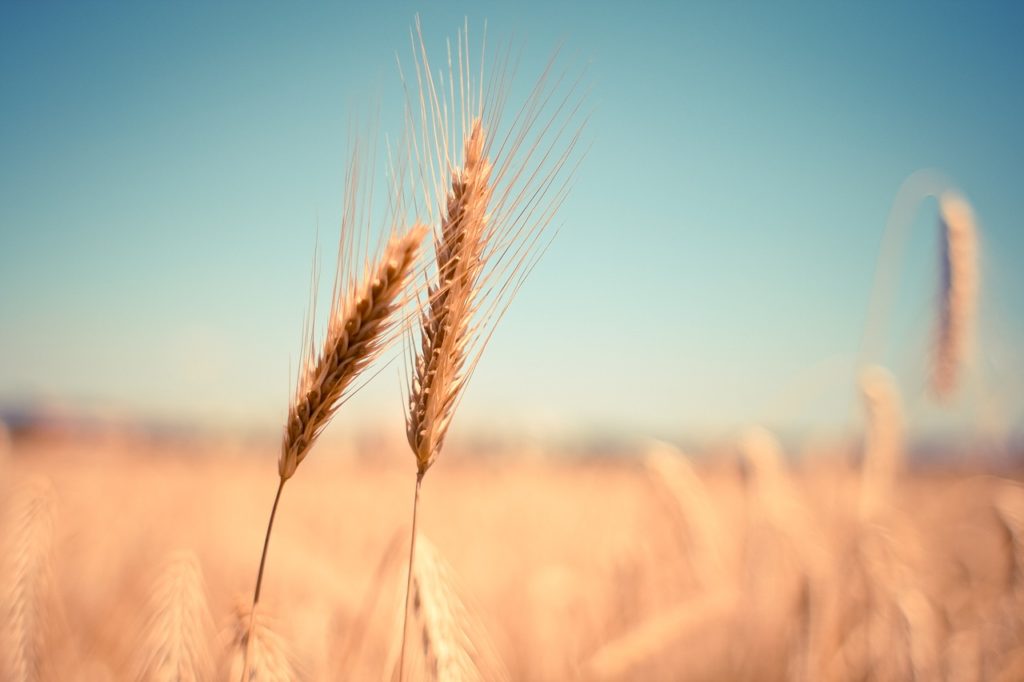Fusarium head blight (FHB), first reported in Canada in 1919, is a fungal disease most often found in wheat. It can also affect barley, oats, rye, corn and some forage grasses. Ontario agronomist Peter Johnson, also known as “Wheat Pete,” says Ontario seems to be the epicentre of FHB._x000D_
_x000D_
“In Ontario, we have pressure every year, and when it is not a widespread issue, we have simply ‘dodged the bullet’ that year,” Johnson says, recalling that an outbreak in Ontario in 1996 had a major impact. “Ninety per cent of Ontario wheat was feed, sample, or worse.”_x000D_
_x000D_
On the Prairies, FHB was first identified in Manitoba in 1923, but did not cause concern until the mid-1980s. Higher levels of infection also occurred in Manitoba in 2005, 2010 and 2014. In Saskatchewan, FHB was first detected in samples from a few wheat fields grown near the Manitoba border in 1993. It is now well established in eastern Saskatchewan and has been moving west. In Alberta, the pathogen has been isolated with increasing frequency since 2001, especially in southern Alberta._x000D_
_x000D_
Also known as tombstone or scab, FHB can cause yield losses, but the bigger impact is on quality. FHB produces white, shriveled kernels in wheat. The grading term for these kernels is fusarium-damaged kernels or FDK. Canadian Grain Commission grades drop quickly with increased presence of FDK. For example: western Canadian hard red spring wheat drops from a No. 1 grade to a No. 2 grade if there is more than 0.25 per cent FDK by weight in the sample. Alberta Agriculture and Forestry estimates that the revenue loss from reduced yield and a downgrade in class from No. 1 wheat to No. 2 is about $52 per acre, and a drop to No. 3 or feed wheat is between $62 and $65 per acre._x000D_
_x000D_
In addition to yield and quality losses, the fungi that cause FHB can produce mycotoxins, such as deoxynivalenol (DON) and zearalenone. In high concentrations, DON can affect weight gain in livestock, and zearalenone can cause reproductive problems. DON in barley negatively impacts the brewing and malting process, so barley is often rejected for malt if DON is detected._x000D_
_x000D_
Fusarium Here to Stay_x000D_
_x000D_
_x000D_
While it has been the subject of research all around the world, there is no “cure” for FHB. Johnson says: “Fusarium is ubiquitous. If weather conditions are ideal for infection, every management option must be utilized to avoid another problem like we had in Ontario in 1996. Virtually all of the fusarium in a field comes from the field, so what growers do on their farms matters.”_x000D_
_x000D_
Fusarium fungi can live on dead and decaying plant matter, overwinter as spores and survive on seed. It can also live on the roots of other crops, including pulses and oilseeds. All current cereal varieties are susceptible to FHB to differing degrees._x000D_
_x000D_
Like Johnson, Kelly Turkington of Agriculture and Agri-Food Canada’s Lacombe research station says: “Diligent management can help to reduce the impact. The focus needs to be on reducing the build-up of infested crop residues and using as many of the management tools available to suppress this disease and hopefully limit its impact.”_x000D_
_x000D_
Pam de Rocquigny, provincial cereal crop specialist with Manitoba Agriculture, Food and Rural Development, agrees. She says FHB is best managed with multiple strategies. “No single management tool will be effective on its own,” she says. “But using genetics (variety selection) together with fungicides — which includes proper timing and application — crop rotation, tillage and seed treatments can have results.”_x000D_
_x000D_
To best control FHB, experts agree growers should start with crop planning, choose less susceptible varieties, know the seed, use treated seed, consider a fungicide application and manage crop residue._x000D_
_x000D_
Start with Crop Planning_x000D_
_x000D_
According to Turkington, crop rotation is an important component in the FHB toolbox, but it has to be diligently practised._x000D_
_x000D_
“Crop rotation can be effective as long as everyone practises a rotation with at least two years between host crops,” he says. “A single year between wheat crops in a canola-wheat-canola-wheat rotation is not sufficient for decomposition of infested residues before the next wheat crop is grown, thus the amount of infested residue will build._x000D_
_x000D_
“Also what is happening in neighbouring fields is critical. You as a grower can have an excellent rotation, but if your neighbours do not, then wind-borne diseases like FHB can easily blow in from adjacent fields.”_x000D_
_x000D_
Turkington also advises that cereals should not be planted into corn stubble._x000D_
_x000D_
Choose Less Susceptible Varieties_x000D_
_x000D_
_x000D_
De Rocquigny says variety selection is one of the first steps in managing FHB. “There has been great genetic advancement made by breeders, and since 1999 average disease resistance for FHB has increased,” she says. “There are two varieties now with a Resistant (R) rating: the winter wheat variety Emerson and the Canadian prairie spring red wheat AAC Tenacious VB. Both varieties have shown a consistent resistance response.”_x000D_
_x000D_
Thirteen Canadian Western Red Spring wheat varieties are rated as moderately resistant. A number of spring and winter wheat varieties are rated moderately resistant for Ontario and Quebec as well._x000D_
_x000D_
“That is great news for farmers who are trying to manage the disease,” says de Rocquigny. However, she warns that resistance does not equal immunity. “Under high levels of the disease, all varieties will sustain damage,” she says._x000D_
_x000D_
The Prairie Grain Development Committee, Ontario Cereal Crops Committee, RGCQ in Québec and the Atlantic Field Crops Committee all publish FHB information for cereal varieties. With the exception of the Atlantic Field Crops Committee, all use the same ratings: Resistant (R), Moderately Resistant (MR), Intermediate (I), Moderately Susceptible (MS) and Susceptible (S). Variety ratings can be found in provincial seed guides._x000D_
_x000D_
Know Your Seed_x000D_
_x000D_
De Rocquigny says seed testing is critical. “It is the most accurate way to identify the presence of disease on or in seed,” she says. “Absence of the typical visual symptoms of FHB does not mean it is fusarium-free seed.”_x000D_
_x000D_
Sarah Foster, president of 20/20 Seed Labs, congratulates those who consistently test their seed._x000D_
_x000D_
“Consistent and regular testing has contributed to an exceptional job of keeping FHB under control in Alberta,” she says._x000D_
_x000D_
20/20 offers different types of testing. One in particular, DNA testing, is proving invaluable, Foster says._x000D_
_x000D_
“The DNA test is very sensitive and we test more seed than the plate, so accuracy goes up. DNA identifies only fusarium and it detects low levels, so it serves as a very good early warning system that FHB is in the area, and early management can begin.”_x000D_
_x000D_
Use Treated Seed_x000D_
_x000D_
The use of seed-applied fungicides is a growing management tool. According to Nathan Klassen of Bayer CropScience’s SeedGrowth division, fungicide seed treatments are recognized as contributing to healthier, more uniform seed stands._x000D_
_x000D_
“The return you get on seed treatment is ensuring you get the seed you put into the ground up and actively growing,” he says. “Plant populations are critical to maximize yield potential and treating your seed ensures the crop emerges evenly, which is key for fungicide application timing later in the season.”_x000D_
_x000D_
Klassen says it’s important to use a treatment that contains both a contact and a systemic fungicide._x000D_
_x000D_
“Contact activity controls pathogens that are on the seed, like fusarium. Systemic activity gets the active ingredient throughout the plant for soil-borne disease. Soil-borne fusarium is always a problem for us in Manitoba,” he says. However, producers need to know treated seed does not “cure” poor seed lots, nor does it prevent infection at flowering, he adds._x000D_
_x000D_
Consider a Fungicide Application_x000D_
_x000D_
Research shows that fungicides applied to varieties with some resistance, at the right time, and in the right way, can suppress FHB on wheat. However, Turkington says: “It’s important to remember that suppression is not control._x000D_
_x000D_
“Moreover, fungicides applied once FHB symptoms are observed will not be effective. Past history, stand uniformity and environmental conditions will all dictate the effectiveness of fungicides.”_x000D_
_x000D_
Turkington applauds the development of fusarium risk assessment tools, and urges growers to use them as an important part of their fusarium management plans._x000D_
_x000D_
Since 2008, Ontario growers have had access to a fusarium risk forecasting system. DONcast was developed at Ridgetown College. It has been refined over the years and is now offered to growers by Weather Innovations, Bayer’s CropScience division and Pride Seeds as part of the Weather Central website. The DONcast calculator uses actual, forecasted and historical weather data along with field-specific agronometric data to accurately predict DON concentrations in wheat at harvest._x000D_
_x000D_
Manitoba Agriculture, Food and Rural Development (MAFRD) provides growers with online FHB risk maps throughout the cereal-growing season. The MAFRD model uses the hours of precipitation and the hours with temperatures between 15 C and 30 C during the previous seven days to determine the level of risk — from low to extreme — throughout the province._x000D_
_x000D_
In 2015, for the first time, the Saskatchewan Wheat Development Commission also offered an FHB risk map. The Saskatchewan model (for spring and winter wheat) uses temperature and relative humidity in the previous five days, plus two days forecast to assess FHB risk due to weather from low to high._x000D_
_x000D_
Turkington and de Rocquigny agree that these tools are very useful, but they are only part of the picture. “The existence of disease requires three factors: the interaction of a susceptible host, a virulent pathogen and an environment favourable for disease development,” de Rocquigny says. “Although a risk map may show high risk due to environment, disease risk may actually be low if the wheat crop is not at the proper stage for infection.”_x000D_
_x000D_
According to Johnson, timing is critical when it comes to fungicide application. He says: “Producers need to scout their wheat fields regularly. Start counting days, with “Day 0” being when 75 per cent of the heads on the main stem are fully emerged. Day 2 to Day 4 are the ideal times to spray.”_x000D_
_x000D_
It is also important to get maximum coverage of the wheat head. A lot of research on nozzle configuration and sprayer height has been done, particularly in Ontario. It is recommended that forward- and backward-mounted spray nozzles or nozzles that have a two-directional spray are used. Spray should be coarse and should be low. The optimum is eight to 12 inches above the wheat canopy._x000D_
_x000D_
Manage Crop Residues_x000D_
_x000D_
Turkington says that management strategies to reduce the amount of infected crop residues may also be beneficial._x000D_
_x000D_
“Chopping and broad distribution of straw may help to enhance decomposition and contribute to an effective FHB management plan,” he says._x000D_
_x000D_
Fusarium head blight is present in cereal-growing areas around the world. It is the subject of a great deal of research. Plant pathologists, wheat and barley breeders and geneticists, agronomists, mycologists, cereal chemists, millers and malt producers have all focused on this complex plant disease. In Canada, progress in plant breeding, fungicides and application technology and forecasting systems have improved the prospects for managing FHB — but there is no cure._x000D_
_x000D_
“Management efforts have been tremendously successful, but when we slip up, as we did in Ontario with a lack of fusarium resistance data on a new variety in 2014, the results rear their ugly heads yet again,” Johnson says. “These are constant reminders that every effort must be made, to reduce and manage this very devastating disease.”













